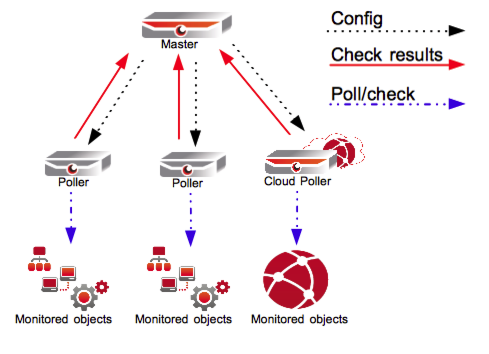Overview
You can scale up an OP5 Monitor environment to monitor more complex infrastructures by adding new servers. The types of server that can make up your monitoring environment are as follows:
- A master server.
- One or more poller servers. Poller servers come in two types: full pollers and Slim Pollers. For a description of the difference, see Distributed monitoring.
- One or more peer servers per master or poller server, for redundancy and load balancing.
Below you can find more details of each server type, and how you configure them to work together.
Monitoring environment
You can configure different types of monitoring environment, based on the complexity of the infrastructure you are monitoring.
Single network segment
This is the simplest monitoring scenario, consisting of a single master server with one or more optional peer servers.
Load-balanced monitoring
You can add a peer for load balancing or redundancy purposes, either to a master or poller server. Note that you can only use peers in the same location, preferably on the same rack.

In a load-balanced monitoring environment, two or more peers share the same tasks. Any configuration updates you perform on any of the peers are distributed to the other peers. The peers divide the load automatically and keep track of each other, so that when one peer goes down, the others take over the tasks. You can add up to a maximum of 5000 peers per master or poller server.
Distributed monitoring
Once you need to extend your monitoring to a distributed environment, for example to monitor a host behind a firewall, in a different data centre, or at a client site, you can add a poller. The distributed model looks like this:

In a distributed monitoring environment:
- All configuration is performed on the master node.
- All configuration updates are distributed to the pollers.
- Each poller node is responsible for its own host group.
- The master node holds all the status information.
Slim Poller
The OP5 Monitor Slim Poller is a scaled-down version of the poller. It is a containerised version of OP5 Monitor and includes only the components needed to run checks and sync the results to the master server. This allows you to run a smaller, more efficient version of OP5 Monitor in cases where you do not need your poller to have a user interface or an HTTP API. Furthermore, it facilitates the deployment of OP5 Monitor into existing cloud or container infrastructures to monitor the services within them.
Limitations of the Slim Poller
The Slim Poller only comes with a subset of the full OP5 Monitor functionality, so has the following limitations.
| Functionality | Limitation |
|---|---|
| User interface | There is no user interface included with a Slim Poller deployment, so you must use the user interface of the master server instead. |
| HTTP API | As there is no HTTP API included, all access to the API must be through the master server. |
| Notifications | The Slim Poller does not include a mail server, so all notifications must be sent from the master server. For more information, see Configure poller notifications through the master in Scale up your monitoring environment. |
| Plugins | Only the most frequently used plugins are included with the Slim Poller. You can install custom plugins if required. For more information, see Install custom plugins on a Slim Poller. |
| Passive mode |
The Slim Poller must be set up in passive mode. The Slim Poller must be able to reach the master on ports |
| Poller mode only | A Slim Poller can only be used in poller mode. It is not possible to set up a Slim Poller as a peer to a master OP5 Monitor node. It is, however, possible to set up poller peers. |
For more information on setting up Slim Poller, see Add a new Slim Poller.
How to configure distributed and load-balanced environments
Once you have added the new pollers and peers, you need to configure them to work together in the OP5 Monitor back end. Note that you can configure a monitoring environment which is both distributed and load-balanced.
For more information on how to install and configure the components you need to scale up your monitoring environment, see Scale up your monitoring environment.